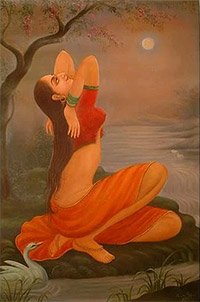Damaruka, Ḍamaruka: 9 definitions
Introduction:
Damaruka means something in Hinduism, Sanskrit. If you want to know the exact meaning, history, etymology or English translation of this term then check out the descriptions on this page. Add your comment or reference to a book if you want to contribute to this summary article.
In Hinduism
Shaktism (Shakta philosophy)
Source: Google Books: ManthanabhairavatantramḌamaruka (डमरुक) (Cf. Ḍamaru) refers to a “double-headed drum”, according to the Kularatnoddyota, one of the earliest Kubjikā Tantras.—Accordingly, “That, O goddess, is said to be the subtle (form), now listen to the gross one. [...] She holds a skull, dagger, javelin and ascetic’s staff. Fierce, she holds a knife, a great noose and sword. (She also holds) a thunderbolt, spear, bow, arrows and double-headed drum [i.e., ḍamaruka]. Her neck is adorned with the great lord of snakes. She wears a snake as a sacred thread and (her) girdle is tied with that also. She is adorned with the thousand-headed lord of the snakes (who is) on (her) head. Snakes are (her) anklets and bangles. Her topknot has the form of a burning fire and scorpions are (her) rings”.

Shakta (शाक्त, śākta) or Shaktism (śāktism) represents a tradition of Hinduism where the Goddess (Devi) is revered and worshipped. Shakta literature includes a range of scriptures, including various Agamas and Tantras, although its roots may be traced back to the Vedas.
Kama-shastra (the science of Love-making)
Source: Shodhganga: Elements of Art and Architecture in the Trtiyakhanda of the Visnudharmottarapurana (kama)Ḍamaruka (डमरुक) refers to a special kind of Drum.—Cf. Vīṇāḍamarukavādyā which refers to “playing Vina and Damaruka, a special kind of Drum”, representing one of the “sixty four kinds of Art”, according to the Kāmasūtra of Vātsyāyaṇa.—Indian tradition, basically includes sixty four Art forms are acknowledged. The references of sixty four kinds of kalā are found in the Bhāgavatapurāṇa, Śaiva-Tantras, Kāmasūtra of Vātsyāyaṇa etc.

Kamashastra (कामशास्त्र, kāmaśāstra) deals with ancient Indian science of love-making, passion, emotions and other related topics dealing with the pleasures of the senses.
Gitashastra (science of music)
Source: Shodhganga: Elements of Art and Architecture in the Trtiyakhanda of the Visnudharmottarapurana (gita)Ḍamaruka (डमरुक) refers to a musical instrument classified as Avanaddha (“those instrument whose mouths are covered with leather (known as avanaddha)”) which represents one of the four kinds of Instrumental Music, produced by an instrument (ātodya), according to the Saṃgītaratnākara.—In the Viṣṇudharmottarapurāṇa and the Saṃgītaratnākara, some examples of avanaddha type of instruments are given, e.g., Ḍamaruka.
Gitashastra (गीतशास्त्र, gītaśāstra) refers to the ancient Indian science of Music (gita or samgita), which is traditionally divided in Vocal music, Instrumental music and Dance (under the jurisdiction of music). The different elements and technical terms are explained in a wide range of (often Sanskrit) literature.
Yoga (school of philosophy)
Source: ORA: Amanaska (king of all yogas): A Critical Edition and Annotated Translation by Jason BirchḌamaruka (डमरुक) or “drum” refers to one of the accoutrements carried by the Sādhaka, according to the Kubjikāmata verse 25.130.—Accordingly: For one who has remembered [the sound of] the ḍamaru [drum] [i.e., ḍamaruka] in the no-mind [state], which is free of ills, Kuṇḍalinī, in the form of Māyā, remains situated in the navel”.

Yoga is originally considered a branch of Hindu philosophy (astika), but both ancient and modern Yoga combine the physical, mental and spiritual. Yoga teaches various physical techniques also known as āsanas (postures), used for various purposes (eg., meditation, contemplation, relaxation).
Languages of India and abroad
Sanskrit dictionary
Source: Cologne Digital Sanskrit Dictionaries: Monier-Williams Sanskrit-English DictionaryḌamaruka (डमरुक):—[from ḍamara] mf(ā ī)n. (n., [cf. Lexicographers, esp. such as amarasiṃha, halāyudha, hemacandra, etc.]) = rin, [Vātsyāyana etc.]
Source: DDSA: Paia-sadda-mahannavo; a comprehensive Prakrit Hindi dictionary (S)Ḍamaruka (डमरुक) in the Sanskrit language is related to the Prakrit words: Ḍamarua, Ḍamaruga.
[Sanskrit to German]
Sanskrit, also spelled संस्कृतम् (saṃskṛtam), is an ancient language of India commonly seen as the grandmother of the Indo-European language family (even English!). Closely allied with Prakrit and Pali, Sanskrit is more exhaustive in both grammar and terms and has the most extensive collection of literature in the world, greatly surpassing its sister-languages Greek and Latin.
Kannada-English dictionary
Source: Alar: Kannada-English corpusḌamaruka (ಡಮರುಕ):—[noun] = ಡಮರ [damara].
Kannada is a Dravidian language (as opposed to the Indo-European language family) mainly spoken in the southwestern region of India.
See also (Relevant definitions)
Starts with: Damarukadhara, Damarukagarbhagaramahatmya, Damarukakara, Damarukara.
Ends with: Odamaruka.
Full-text: Tamarocai, Tamarakavoli, Damarua, Damaruga, Vinadamarukavadya, Vina, Avanaddha, Damaru.
Relevant text
Search found 12 books and stories containing Damaruka, Ḍamaruka; (plurals include: Damarukas, Ḍamarukas). You can also click to the full overview containing English textual excerpts. Below are direct links for the most relevant articles:
The Skanda Purana (by G. V. Tagare)
Chapter 4 - Ḍamarukeśvara (ḍamaruka-īśvara-liṅga) < [Section 2 - Caturaśīti-liṅga-māhātmya]
Chapter 212 - The Greatness of Ekaśāla Ḍiṇḍimeśvara (ḍiṇḍima-īśvara-tīrtha) < [Section 3 - Revā-khaṇḍa]
Chapter 99 - The Greatness of Nāgeśvara (nāga-īśvara-tīrtha) < [Section 3 - Revā-khaṇḍa]
Cosmetics, Costumes and Ornaments in Ancient India (by Remadevi. O.)
2.5. Various other Hand Ornaments < [Chapter 3 - Ornaments]
The Religion and Philosophy of Tevaram (Thevaram) (by M. A. Dorai Rangaswamy)
Chapter 4.6 - (m) Symbology of the Utukkai (Udukkai) < [Volume 2 - Nampi Arurar and Mythology]
Rudra-Shiva concept (Study) (by Maumita Bhattacharjee)
3. Weapons of Śiva < [Chapter 5 - Rudra-Śiva in the Purāṇic Literature]
The Shiva Purana (by J. L. Shastri)
Chapter 21 - Description of the Special War < [Section 2.5 - Rudra-saṃhitā (5): Yuddha-khaṇḍa]
The Bhagavata Purana (by G. V. Tagare)
The Sixty-four arts and crafts (Kalā) < [Appendices]